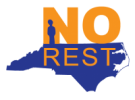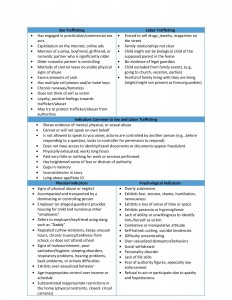Screening and Intake
Definitions
The following definitions were developed by project participants of the work groups on Screening and Intake and Services and Practices to provide an understanding of human trafficking terms from the perspectives of multiple disciplines, to develop a consistent definition of terms for ongoing use in this and other projects, and to frame the development and implementation of the Comprehensive Strategic Plan.
Intake is the formal process of gathering in-depth information or the circumstances of the case. Depending on the discipline the intake process might involve gathering information from secondary sources such as community members or health care professionals, or from the primary sources of the victims themselves. The primary concern during the intake process is the safety of the survivor and of the agency or discipline receiving the information. Depending on the agency involved, the victim might participate in the intake process either via phone or in person, providing information about her or his experiences and needs. The information gathered during the intake process can be used to inform one or more of the following processes: screening, assessment, and services.
Screening can vary by discipline, but typically involves one or both of the following processes: receiving information from the community, and determining the agency’s response and/or referral. Screening can also be used as a precursor to the intake process. The screening process involves identifying trafficking victims, identifying indicators or red flags for victimization, addressing victims’ safety concerns, and identifying other needs and making necessary referrals. The type of information gathered during the screening process can vary according to the age of the victim, or others involved in either the trafficking situation or the screening interview. The victim might participate in the screening process by phone or in person, depending on the agency involved. Screening interviews with victims gather information about their experiences and their needs. The information gathered and/or discussed during the screening process can be used to inform the following processes: intake, assessment, and service determination.
Assessment is the evaluation of a survivor’s strengths and needs for the purposes of determining a plan of action for the survivor’s health, safety, and well-being. Assessment should be ongoing and periodic because it is important to re-evaluate the plan of action. The assessment process can take place at all stages of service delivery, and will likely vary depending on the discipline responsible for managing the survivor’s care.
Service is a trauma-informed, multidisciplinary approach to ensuring a survivor’s needs are met (including, but not limited to, managed care, housing, medical, mental health, and legal services). The Substance Abuse and Mental Health Services Administrations (SAMHSA) describes trauma-informed services as those offered by a program, organization, agency, or other system of care that has the following characteristics:
Realizes the widespread impact of trauma and understands potential paths to recovery; Recognizes the signs and symptoms of trauma in clients, families, staff, and others involved with the system; Responds by fully integrating knowledge about trauma into policies, procedures, and practice; and, seeks to actively resist re-traumatization. (SAMHSA, 2014, para. 1)
Practice encompasses the various established methods used to deliver services. Standards of care include the using evidence-based programs, policy, and agency protocols to create a process or system to provide services. These standards should be used to guide best practice.
A multidisciplinary team (MDT) is a group of professionals from multiple disciplines and/or agencies who choose to work collaboratively to address the comprehensive needs and services to support the survivor. The disciplines involved in an MDT can vary depending on the case, as can the structure and functions of a MDT. For example, an MDT might be a formal arrangement with a standard or predetermined set of professionals participating; meetings of MDTs that use this formal structure will not include the victim. In cases of MDTs with less formal structures, MDT meetings might include the victims (e.g., Child and Family Team Meetings).
County child welfare agency. North Carolina has a state-supervised, county-administered child welfare system; direct child welfare services are provided at the county level. The term county child welfare agency refers to the public county agency responsible for the provision of child protective services. These agencies can be county departments of social services or consolidated human services agencies.
Victim. The term victim is used throughout the Screening and Intake section of the Strategic Plan to reflect that a child or young person has been harmed and may not currently be in a safe situation. The term victim is more appropriate for use in the Screening and Intake section of the plan, because it implies the individual has recently been identified as someone who has been trafficked and whom a crime was committed against.
Survivor. The term survivor is used throughout the Services and Practice section of the Strategic Plan to reflect that a child or young person is no longer in a harmful situation and has been provided with appropriate supportive services to promote safety, stability, healing, and well-being. The term survivor is more appropriate for the Services and Practice section of the plan because it implies empowerment of the individual and movement toward recovery.
Trafficking Indicators
(click to view)

